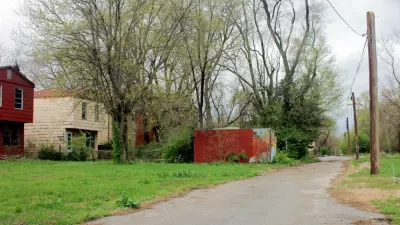For the first time since the start of the Great Recession, America's median household incomes and poverty levels didn't worsen. However, stagnant incomes weigh heavily on the majority of Americans, while the top earners continue to do well.
"Last year, for the first time in half a decade, median household income did not fall and poverty did not rise, the Census Bureau said Tuesday in the release of its major annual report on poverty, insurance and earnings," reports Annie Lowrey. That's the supposed good news.
The most depressing element of the report "is the stagnant income growth among median-wage earners and lower," writes Next City's Bill Bradley. "Economic growth since 1967 has delivered rising incomes, but only for those above the median income level. All that inequality at the heart of mayoral races across the country and President Obama’s economic push? It’s a very real thing."
Writing in The Washington Post's "Wonkblog", Neil Irwin puts a different, but equally troubling, spin on long term household income trends. "In 1989, the median American household made $51,681 in current dollars (the 2012 number, again, was $51,017). That means that 24 years ago, a middle class American family was making more than the a middle class family was making one year ago," he notes. "This isn't a lost decade for economic gains for Americans. It is a lost generation."
FULL STORY: Median Income and Poverty Rate Hold Steady, Census Bureau Finds

Maui's Vacation Rental Debate Turns Ugly
Verbal attacks, misinformation campaigns and fistfights plague a high-stakes debate to convert thousands of vacation rentals into long-term housing.

Planetizen Federal Action Tracker
A weekly monitor of how Trump’s orders and actions are impacting planners and planning in America.

San Francisco Suspends Traffic Calming Amidst Record Deaths
Citing “a challenging fiscal landscape,” the city will cease the program on the heels of 42 traffic deaths, including 24 pedestrians.

Defunct Pittsburgh Power Plant to Become Residential Tower
A decommissioned steam heat plant will be redeveloped into almost 100 affordable housing units.

Trump Prompts Restructuring of Transportation Research Board in “Unprecedented Overreach”
The TRB has eliminated more than half of its committees including those focused on climate, equity, and cities.

Amtrak Rolls Out New Orleans to Alabama “Mardi Gras” Train
The new service will operate morning and evening departures between Mobile and New Orleans.
Urban Design for Planners 1: Software Tools
This six-course series explores essential urban design concepts using open source software and equips planners with the tools they need to participate fully in the urban design process.
Planning for Universal Design
Learn the tools for implementing Universal Design in planning regulations.
Heyer Gruel & Associates PA
JM Goldson LLC
Custer County Colorado
City of Camden Redevelopment Agency
City of Astoria
Transportation Research & Education Center (TREC) at Portland State University
Jefferson Parish Government
Camden Redevelopment Agency
City of Claremont



























